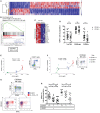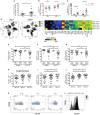CD161 Defines a Functionally Distinct Subset of Pro-Inflammatory Natural Killer Cells
- PMID: 29686665
- PMCID: PMC5900032
- DOI: 10.3389/fimmu.2018.00486
CD161 Defines a Functionally Distinct Subset of Pro-Inflammatory Natural Killer Cells
Abstract
CD161 is a C-type lectin-like receptor expressed on the majority of natural killer (NK) cells; however, the significance of CD161 expression on NK cells has not been comprehensively investigated. Recently, we found that CD161 expression identifies a transcriptional and innate functional phenotype that is shared across various T cell populations. Using mass cytometry and microarray experiments, we demonstrate that this functional phenotype extends to NK cells. CD161 marks NK cells that have retained the ability to respond to innate cytokines during their differentiation, and is lost upon cytomegalovirus-induced maturation in both healthy and human immunodeficiency virus (HIV)-infected patients. These pro-inflammatory NK cells are present in the inflamed lamina propria where they are enriched for integrin CD103 expression. Thus, CD161 expression identifies NK cells that may contribute to inflammatory disease pathogenesis and correlates with an innate responsiveness to cytokines in both T and NK cells.
Keywords: CD161; cytomegalovirus; human immunodeficiency virus; inflammatory bowel diseases; natural killer cells; pro-inflammatory cytokines.
Figures






References
Publication types
MeSH terms
Substances
Grants and funding
LinkOut - more resources
Full Text Sources
Other Literature Sources
Medical
Molecular Biology Databases
Research Materials

